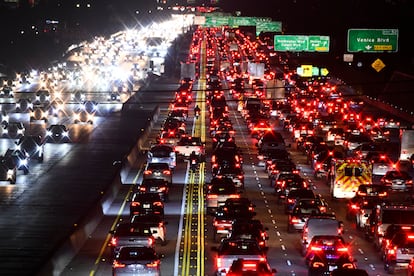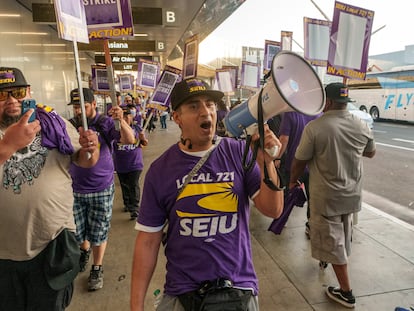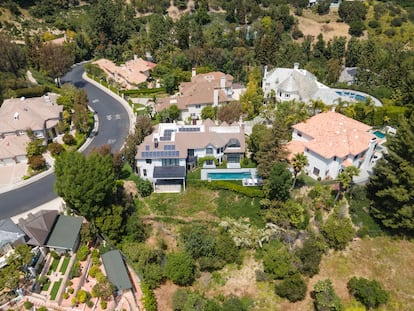The eternal chaos of traffic in Los Angeles
The second-largest city in the United States has promised to invest $120 billion over the next 40 years in fixing its faulty public transportation system


Welcome to Los Angeles! The promised land, the wild west of movie glamour, Santa Monica’s beaches and the famous Hollywood sign. Have you arrived at the airport? Then get ready for the chaos. For starters, it’s going to be hard to just get out of LAX, the county’s main airfield. And when you do, you’ll have your first immersive experience of the city.
Getting around the second-largest city in the United States is mission impossible. Buses (which move 70% of users) are scant and slow, always stuck in impossible traffic. The subway, which is also limited as the lines are used by other trains, has few routes and low frequency. What’s more, it’s not always a pleasant or safe way to travel.
To address these problems, Los Angeles is going to invest a stratospheric $120 billion in its public transportation network over the next 40 years, until 2056. The funds will come from money raised from a specific tax. But while it seems like a huge investment, it’s not a lot for a city where 10 million citizens are lost without a car. Authorities in Los Angeles even recognize this in the strategic transportation plan, which is aimed towards improving mobility for the 2028 Olympic Games. The city will also host some of the games of the Men’s World Cup in 2026.
“Our current transportation system is highly congested because roadway space is inefficiently used,” states the document, which notes that the most disadvantaged members of the community have limited options for getting around. The plan seeks to provide “high-quality mobility options” within a 10-minute walk from a resident’s home, with shorter waiting times (maximum 15 minutes), faster connections and more reliable service.
But as in every city, the entrance to Los Angeles is the airport. And that’s where the chaos begins. When leaving the baggage collection area in the international terminal, travelers have to walk up an upward, curved ramp. But that’s just the first challenge. The narrow exit doors of the terminals mean that two people cannot exit at the same time. Then, there are more complications. There is no subway, and there is only one public bus, which goes to Union Station — a transportation hub and financial center, where hardly anyone lives or stays. This 40-minute journey costs $10.
So how do the 65 million travelers who arrive in LAX every year — a number that rose to 88 million before the pandemic — leave the airport? By car. Around 32 million cars pass through LAX every year, which leads to terrible traffic around the airport. Indeed, the traffic is so bad that taxis and ride-hailing services are not allowed inside the airport. This means travelers have to catch a sluggish bus labeled LAX-it (a play on words with exit) that leads to another terminal, a kind of open field, where it is possible to hail a ride.
When applications such as Uber and Lyft appeared a decade ago, the cost of the rides was so low — especially considering the high prices in California — that they became an instant success. So much so that now there are hardly any taxis. Meanwhile, rates for ride-hailing services have skyrocketed.
The future lies in the subway, and LA authorities know it. LAX has invested $15 billion to modernize its eight terminals and to link them by small Automated People Movers — some of which are already operating. A low-cost car park has also been created. But it’s far away: travelers need to catch a bus to get there.
But the subway is still the main focus. The C Line, far from the most touristic centers of the city (located more south-central, without connection to Downtown, Hollywood or Santa Monica), reaches a stop in the middle of nowhere called Aviation/LAX. From there, a connection is being built to connect the C Line with the more popular K Line, which is set to one day reach the glamorous West Hollywood and Aviation. And from there, an ambitious $900 million project will start: a hub with buses from all over the city, a drop-off zone for car passengers, bicycle parking and shops. An Automated People Mover will also take travelers from the station to the airport.
“Everyone traveling to or from LAX should have access to modern, reliable public transportation that gets them to their destination on time,” said then Los Angeles Mayor Eric Garcetti, when he inaugurated the project in 2021. When he presented the plan, the station was scheduled to be completed in 2024. But, for now, there is only concrete, steel and hardhats. And it is more than four miles from LAX terminals. Better call the next taxi.
Sign up for our weekly newsletter to get more English-language news coverage from EL PAÍS USA Edition
Sobre la firma










































